You’ll need workshop lights that deliver at least 9,000 lumens to achieve the precision and detail visibility required for professional-quality bench work. High-efficiency LED fixtures outperform halogen alternatives by providing superior brightness while consuming 75% less energy and lasting over 25,000 hours. Choose adjustable multi-panel systems with 4,000K-5,000K color temperature to eliminate shadows and reduce eye strain during extended sessions. Strategic positioning and dimming controls optimize your workspace efficiency and comfort for any task.
Essential Lumens Requirements for Precision Jewelry Work

When you’re working on intricate jewelry pieces, you’ll need a minimum of 1,500 to 2,000 lumens to see fine details clearly and prevent eye strain during extended sessions.
This lighting requirement guarantees you can distinguish between subtle color variations in gemstones and execute precise cuts without errors.
High-efficiency LED garage light fixtures offering 9,000 lumens provide exceptional workspace illumination while maintaining low power consumption and minimal heat generation.
You’ll want adjustable LED lights positioned directly over your workbench, allowing focused illumination for specific tasks like soldering or stone setting.
Proper lighting between 4,000K and 5,000K color temperature mimics natural daylight, giving you accurate color assessment capabilities.
Adequately illuminated workspaces dramatically improve your accuracy and reduce costly mistakes in detailed jewelry production work.
LED Vs Halogen Lighting Performance Comparison
Choosing the right lighting technology for your workshop greatly impacts both performance and operating costs. When comparing LED and halogen options, LEDs deliver considerably better efficiency and brightness. A 150-watt LED produces over 22,000 lumens, while a 100-watt halogen only generates 1,000 lumens.
| Feature | LED | Halogen |
|---|---|---|
| Lumens per Watt | ~100 | ~15 |
| Lifespan (Hours) | 25,000+ | 2,000 |
| Heat Generation | Low | High |
| Color Temperature | Customizable (4,000K recommended) | Fixed (~3,000K) |
You’ll save considerably on replacement costs since LEDs last over 12 times longer than halogen bulbs. LEDs also reduce cooling expenses by operating at lower temperatures. The customizable color temperature options let you optimize lighting conditions for detailed work, making LEDs the superior choice for professional workshops.
Color Temperature Selection for Gemstone Evaluation
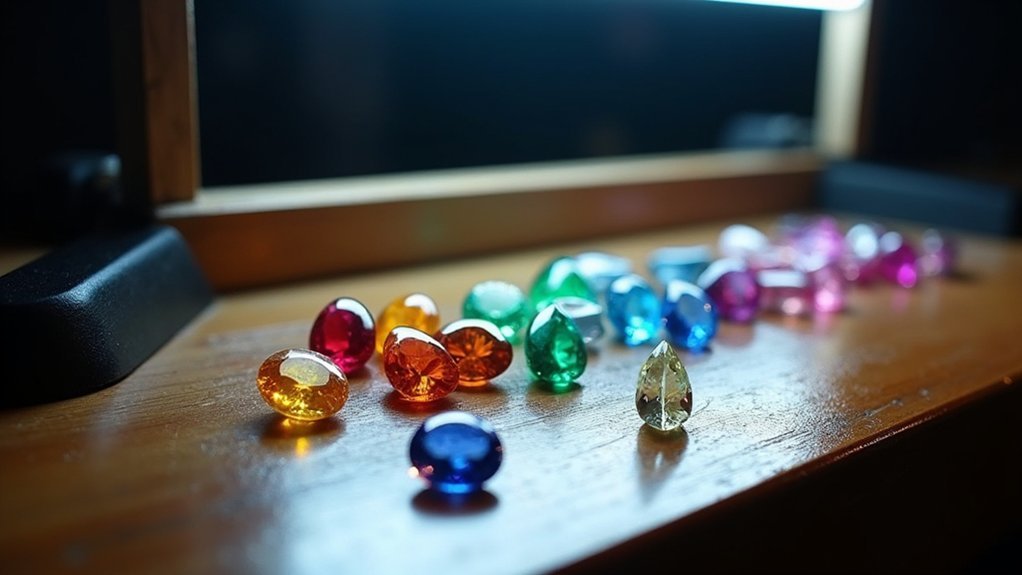
When selecting workshop lights for gemstone evaluation, you’ll need to focus on the ideal color temperature range of 4,000K to 6,500K to guarantee accurate color assessment.
Your choice within this range directly impacts how you perceive a stone’s true colors and subtle variations.
Consider that 5,000K provides excellent color accuracy for most evaluations, while 6,500K mimics natural daylight for the most detailed inspections.
Optimal Color Temperature Range
Color temperature selection plays a critical role in gemstone evaluation, directly affecting your ability to assess a stone’s true characteristics and value. You’ll achieve ideal results using lights between 4,000K and 5,000K, which provide the perfect balance of warm and cool tones for accurate color assessment.
| Color Temperature | Light Quality | Best For |
|---|---|---|
| 4,000K | Warm white | Extended evaluation sessions |
| 4,500K | Neutral white | General gemstone grading |
| 5,000K | Ultra-white daylight | Precise color assessment |
| 5,500K | Cool daylight | Diamond clarity evaluation |
| 6,000K | Cool white | Technical documentation |
Choose LED fixtures for consistent color rendering and energy efficiency. The 5,000K temperature closely mimics natural daylight, revealing true gemstone colors without distortion. For longer evaluation sessions, you’ll find 4,000K reduces eye strain while maintaining adequate detail visibility.
Evaluating Stone Color Accuracy
Accurate gemstone color evaluation depends on more than simply selecting the right color temperature—you must understand how different lighting conditions reveal or mask a stone’s true hues.
Choose LED lights with 5,000K to 6,500K color temperature to mimic natural daylight and guarantee precise color assessment. You’ll want high-CRI LEDs over traditional incandescent bulbs, which distort colors due to their inferior color rendering capabilities.
Install high bay LED lights providing 21,000 lumens to flood your workspace with consistent illumination. Complement this with adjustable LED panels that let you direct focused light exactly where you need it.
This combination maximizes visibility and reveals subtle color variations that determine a gemstone’s true value. Avoid 4,000K lighting during evaluation—while easier on your eyes, it provides warmer tones that compromise color accuracy.
Adjustable Positioning Features for Optimal Coverage
Although many workshop lights provide adequate illumination, adjustable positioning features transform good lighting into exceptional coverage that adapts to your specific needs. The HIGH BRIGHT™ 9000 LED garage light exemplifies this versatility with four independently adjustable panels that tilt up to 90°.
Here’s how adjustable positioning enhances your workspace:
- Eliminates shadows by directing light precisely where you’re working
- Covers 860 square feet effectively through strategic panel positioning
- Adapts to changing tasks without requiring multiple light sources
- Reaches every corner of your workspace through tilting and rotating capabilities
You’ll find that adjustable lights outperform fixed-position alternatives in dynamic work environments.
Whether you’re doing detailed bench work or general garage tasks, independent panel control guarantees ideal visibility exactly where you need it most.
Power Consumption and Energy Efficiency Ratings
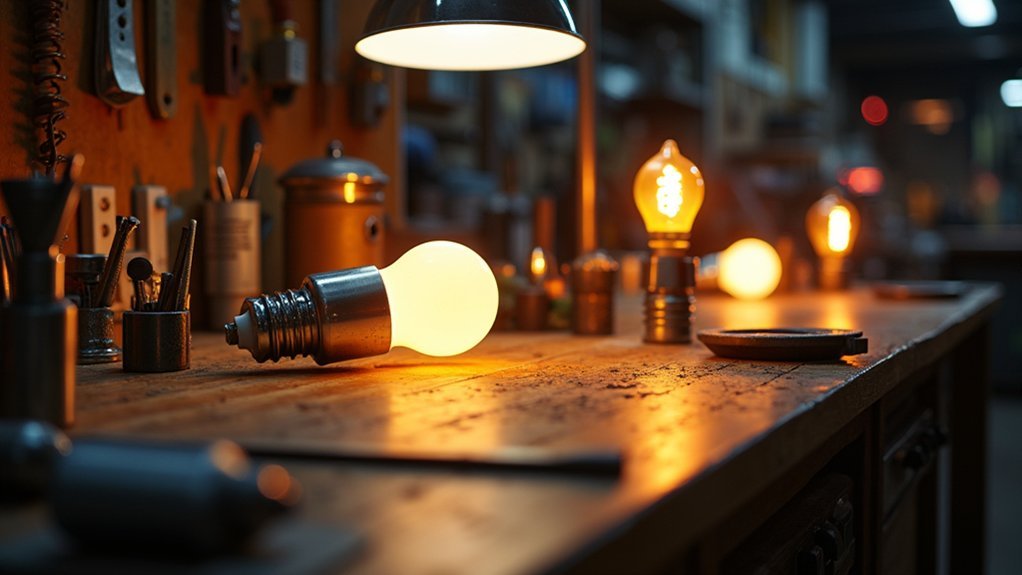
You’ll want to understand how watts relate to lumens output when choosing workshop lights, as this relationship determines both brightness and energy costs.
LED technology offers remarkable efficiency benefits compared to traditional lighting, with high bay LEDs producing up to 21,000 lumens while consuming only 100-250W.
This efficiency translates into significant cost savings over time, especially when you’re running multiple lights for extended workshop sessions.
Watts Vs Lumens Output
Understanding the difference between watts and lumens fundamentally changes how you select workshop lighting.
You’re no longer stuck choosing bulbs based solely on power consumption. Instead, you can prioritize brightness while minimizing energy costs.
Here’s what you need to know:
- Traditional incandescent bulbs produce about 1,000 lumens per 100 watts.
- Modern LED bulbs deliver the same brightness using only 10-20% of the power.
- A 60-watt LED typically produces around 800 lumens, vastly outperforming incandescent equivalents.
- Higher lumens-per-watt ratings indicate superior efficiency—80 lumens per watt beats 60 lumens per watt.
You’ll save money and get better illumination by focusing on lumens output rather than watts consumed.
LEDs consistently offer the best value for workshop applications.
LED Efficiency Benefits
When comparing energy consumption across lighting technologies, LED workshop lights demonstrate remarkable efficiency that translates directly into cost savings.
You’ll find that high-performance models like the HIGH BRIGHT™ 9000 consume just 60 watts while delivering an impressive 9,000 lumens. That’s exceptional value for your workshop lighting needs.
LED fixtures typically range from 30W to 250W, letting you customize power consumption based on your specific requirements.
You’ll achieve energy efficiency ratings exceeding 90%, making LEDs a sustainable choice for any workspace. The integrated technology guarantees longer lifespans while greatly reducing electricity costs over time.
Cost Savings Analysis
Since LED workshop lights consume considerably less power than traditional alternatives, the cost savings become apparent immediately on your electricity bill.
You’ll see dramatic efficiency improvements when comparing LED fixtures to outdated incandescent options.
Here’s what you can expect from switching to LED workshop lighting:
- Energy consumption reduction – Save up to 75% on electricity costs compared to traditional lighting
- Extended lifespan – LED fixtures last up to 25,000 hours, reducing replacement expenses
- Flexible power options – Choose from 30W to 120W ratings based on your workspace requirements
- Superior efficiency ratios – Get 9,000 lumens from just 60W, or 21,000 lumens from 150W
These efficiency gains translate directly into lower monthly utility bills while providing brighter, more consistent illumination for your workshop projects.
Mounting Options for Different Bench Configurations
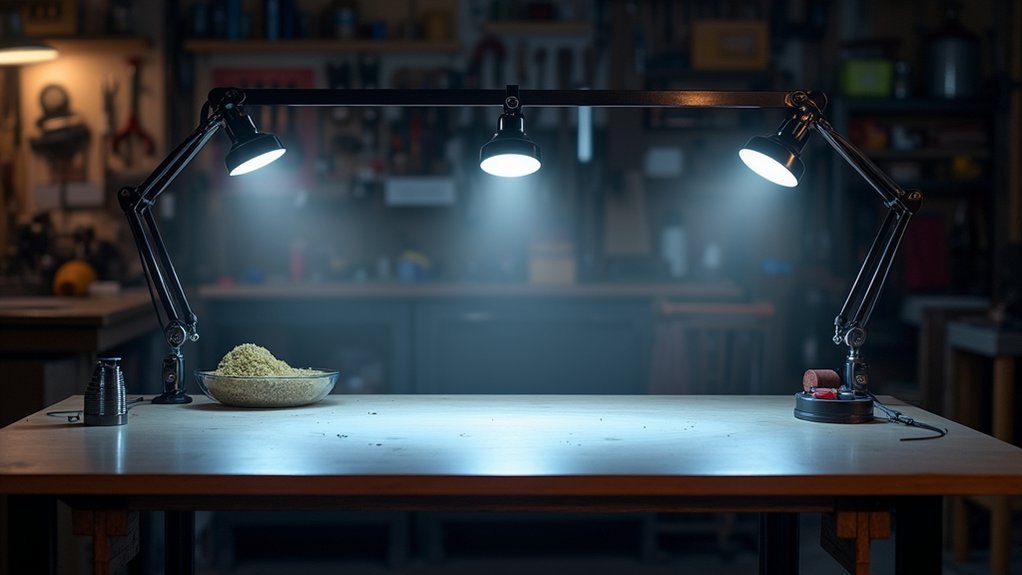
Your workbench configuration determines which mounting approach will deliver the most effective lighting solution. For standard setups, you can mount high bay LED lights at 13 feet using 100W to 250W fixtures based on your workspace size.
Proper workbench configuration ensures optimal mounting approach for high bay LED fixtures at 13-foot heights with appropriate wattage selection.
You’ll have installation flexibility with hardwired or plug-in options depending on your bench layout and electrical access.
If you need adjustable lighting, consider fixtures like the HIGH BRIGHT™ 9000 with multiple LED panels that let you customize directional lighting for specific tasks.
You can enhance illumination by adding reflectors to direct more light onto your work surface. For larger workshops, use zigzag pattern wiring to group lights together, allowing you to control sections independently and optimize energy usage based on your current workspace needs.
Shadow Reduction Techniques With Multi-Panel Designs
You’ll eliminate frustrating shadows in your workshop by strategically positioning multiple light panels to create overlapping coverage zones.
When you angle each panel differently, you’re directing light from various sources to fill in the dark spots that single overhead fixtures can’t reach.
The adjustable nature of multi-panel systems lets you fine-tune each light’s direction, ensuring your workbench receives even illumination from multiple angles.
Panel Positioning Strategies
When you’re working with multi-panel LED lights like the HIGH BRIGHT™ 9000, proper panel positioning becomes your most powerful tool for eliminating shadows that compromise workspace visibility.
You can adjust each panel up to 90° to create strategic lighting angles that transform your workshop’s illumination.
Here’s how to maximize your multi-panel setup:
- Angle panels toward your workbench to concentrate brightness where you need it most while reducing harsh glare.
- Direct corner panels outward to illuminate hard-to-reach areas and eliminate dark spots.
- Create overlapping light zones by positioning panels at different angles for even coverage.
- Use opposing angles to minimize shadows from multiple directions simultaneously.
This strategic positioning approach, combined with high-output fixtures like Hyperlite high bay lights delivering 21,000 lumens, guarantees your detailed projects remain clearly visible.
Overlapping Light Coverage
Strategic panel angling sets the foundation, but overlapping light coverage takes shadow elimination to the next level. You’ll achieve superior workspace illumination by positioning multiple panels to create intersecting light zones. The HIGH BRIGHT™ 9000 delivers 9,000 lumens across adjustable panels that rotate up to 90°, letting you direct light precisely where you need it.
This technique proves especially effective in larger workshops, providing even coverage across 860 square feet. You’ll eliminate dark corners and minimize shadows on critical work surfaces through strategic overlap patterns.
| Panel Configuration | Coverage Area | Shadow Reduction |
|---|---|---|
| Single Panel | Limited zones | Moderate |
| Dual Overlap | Extended reach | Significant |
| Triple Overlap | Complete coverage | Maximum |
Mount panels at varying heights and angles to optimize overlapping zones, enhancing precision task performance.
Adjustable Angle Benefits
While overlapping coverage creates the foundation for shadow-free lighting, adjustable angle benefits multiply your control over workspace illumination.
You’ll discover that multi-panel designs with 90° adjustment capabilities transform how you tackle detailed projects.
Here’s how adjustable angles enhance your workshop efficiency:
- Direct light precisely where you need it most, eliminating stubborn shadows behind tools and materials.
- Reduce eye strain by positioning panels to minimize glare while maintaining ideal brightness levels.
- Create even distribution across your entire workbench, preventing dark spots that cause mistakes.
- Maximize coverage area by spreading 9,000 lumens strategically across multiple work zones.
You’ll find this flexibility particularly valuable during intricate tasks like electronics assembly or fine woodworking, where consistent illumination means the difference between precision and errors.
Heat Output Considerations for Comfort During Extended Sessions
Extended workshop sessions demand lighting that won’t turn your workspace into a sauna. High-output LED lights, like Hyperlite models, emit minimal heat compared to traditional incandescent bulbs, making them perfect for extended use without discomfort.
The HIGH BRIGHT™ 9000’s 60-watt power draw considerably reduces thermal output while delivering exceptional brightness.
You’ll want to position high-ceiling fixtures, such as 150W units mounted at 13 feet, to enhance illumination while minimizing direct heat exposure. Properly spaced high bay lights distribute light effectively without overheating confined areas, maintaining comfortable temperatures during long sessions.
Consider lights with cooler color temperatures around 4,000K, as these cooler hues create less perceived heat and provide a more comfortable working atmosphere for extended projects.
Dimming Controls for Variable Task Requirements
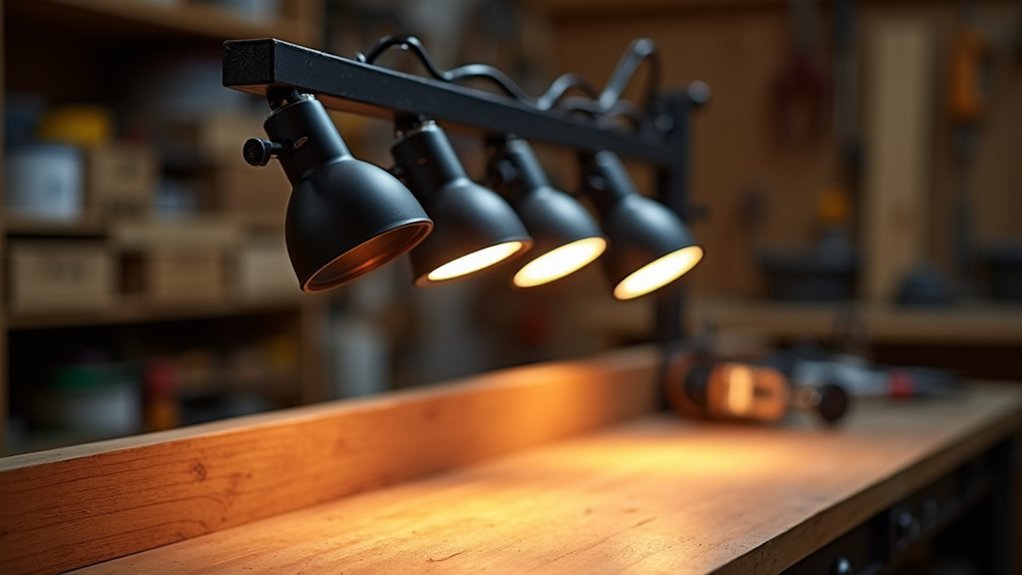
Workshop lighting needs shift constantly throughout the day as you move between precision assembly, rough cutting, and general maintenance tasks.
Dimming controls give you the flexibility to adjust brightness levels without switching fixtures or wasting energy on unnecessary illumination.
Modern LED workshop lights with dimming capabilities offer several key advantages:
Adjustable LED workshop lighting delivers energy efficiency, longer fixture life, visual comfort, and smart control convenience for any task.
- Energy savings – You’ll reduce power consumption when full brightness isn’t required for basic tasks.
- Extended fixture lifespan – Lower brightness settings generate less heat, minimizing component wear.
- Enhanced visual comfort – You can fine-tune lighting levels for detailed work without eye strain.
- Smart control options – Many fixtures now support mobile app or voice command dimming.
High bay LED lights from manufacturers like Hyperlite integrate seamlessly with dimmer switches, letting you customize your workspace lighting for maximum productivity.
Eye Strain Prevention Through Proper Light Distribution
When poor light distribution forces your eyes to constantly adjust between bright spots and shadows, fatigue sets in quickly during detailed workshop tasks. Proper lighting eliminates harsh shadows and glare that strain your vision during prolonged work sessions.
High-lumen LED lights delivering 9,000 lumens enhance visibility for precision tasks. Choose fixtures with 4,000K to 5,000K color temperature to balance brightness and warmth while maintaining color clarity. Install multiple fixtures in a zigzag pattern for consistent illumination across your workspace.
| Light Feature | Eye Strain Benefit |
|---|---|
| Even Distribution | Eliminates harsh shadows |
| 9,000 Lumens | Enhances detail visibility |
| 4,000K-5,000K | Reduces fatigue |
| Adjustable Panels | Directs light precisely |
Adjustable LED panels let you direct light exactly where needed, preventing localized glare and ensuring comfortable working conditions for intricate activities.
Budget-Friendly High-Performance Lighting Alternatives
Since workshop lighting doesn’t require premium fixtures to achieve professional results, you can find LED alternatives that deliver exceptional brightness without straining your budget.
Modern LED options offer incredible value, with some fixtures providing up to 21,000 lumens while consuming only 150 watts of power.
Consider these budget-friendly options for your workshop:
- HIGH BRIGHT™ 9000 LED garage lights – Deliver 9,000 lumens using just 60 watts and fit standard household sockets.
- High bay LED lights – Available in 100W to 250W options, perfect for different mounting heights.
- Adjustable LED panel fixtures – Let you direct light precisely where you need it most.
- Multi-pack purchases – Provide significant cost savings when lighting larger workshop areas.
You’ll achieve professional-grade illumination without overspending on expensive lighting solutions.
Frequently Asked Questions
How Bright Should a Workbench Light Be?
You’ll want your workbench light to provide 1,000 to 2,000 lumens for detailed tasks. Choose LED lights with 4,000K color temperature for balanced brightness that won’t strain your eyes during extended work sessions.
Is 5000K or 6500K Better for Workshop?
You’ll find 5000K better for workshop use since it mimics natural daylight, reducing eye strain during long work sessions. While 6500K offers sharper contrast for precision tasks, it can cause fatigue over time.
How Many Lumens Do I Need for a Workshop Light?
You’ll need 300-800 lumens per square meter for general workshop lighting. Your workbench requires 1,500-3,000 lumens for detailed tasks. Use multiple fixtures to eliminate shadows and guarantee even illumination across all work surfaces.
What Is the Brightest Light for a Garage?
You’ll find Hyperlite high bay LED lights are the brightest garage option, producing up to 21,000 lumens each. They’re available in 100W-250W variants, making them considerably brighter than standard garage lighting solutions.
In Summary
You’ll transform your jewelry workspace with the right lighting investment. Choose LED options with 2000+ lumens and adjustable color temperature between 4000-6500K for accurate gemstone evaluation. Don’t overlook positioning flexibility and dimming controls – they’ll reduce eye strain during detailed work. While quality lights cost more upfront, you’ll save on energy bills and replacement bulbs. Remember, proper illumination isn’t just about brightness; it’s about creating comfortable, sustainable working conditions that’ll enhance your craftsmanship for years.



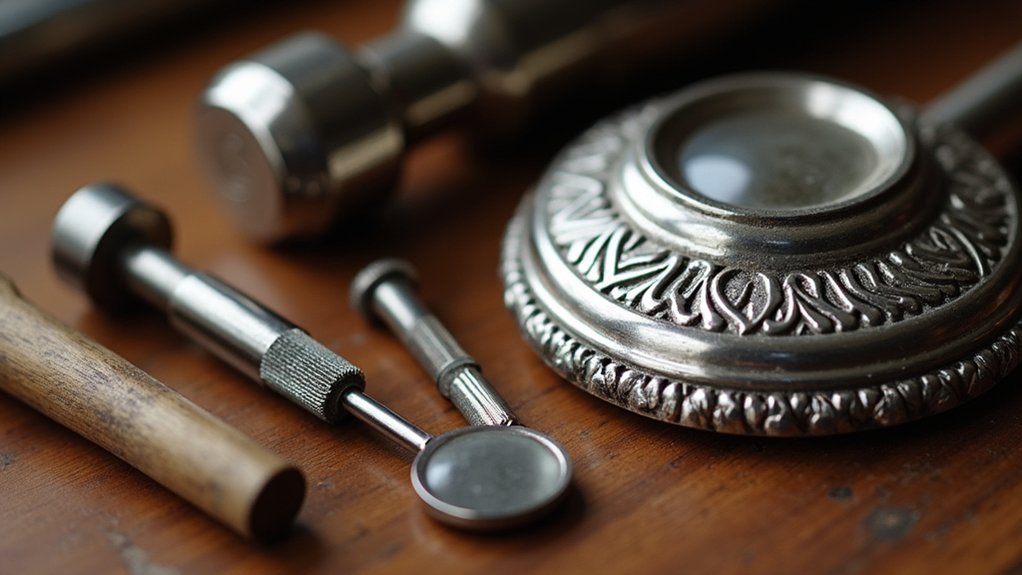
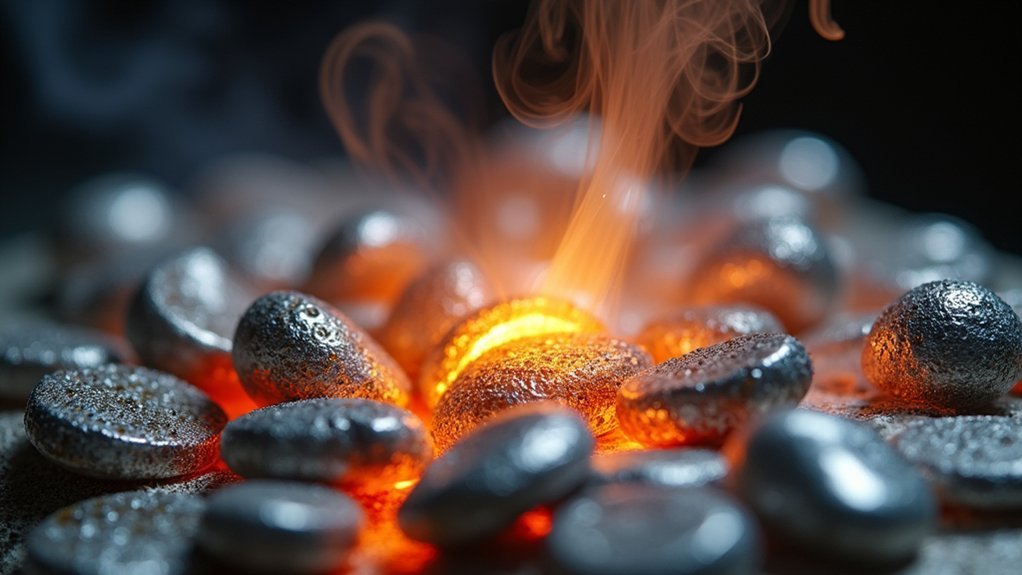
Leave a Reply